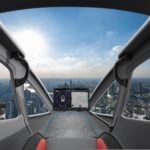A Q&A Session with Matthew Dimmick and Jason Mayfield.
I have been working in consulting and security for many years and have led program development for corporate headquarters, industrial sites, high-net-worth residences, government facilities, and installations. In my experience, the application of Crime Prevention Through Environmental Design (CPTED) and its associated strategies are often viewed as hoo-haw or feel-good stuff by physical security professionals who are focused more on target hardening, technical security, and operational security measures.
In fact, my role in the World Trade Center Reconstruction was just that. I was part of the team that developed the security ConOps, negotiated security staffing requirements, built screening programs, and developed operational plans for the new campus. In this effort, the police and our security consulting team collaborated with engineers, architects, landscape architects, realty consultants, and foundation members, all of whom were dedicated to securing the grounds, memorial, and, most importantly, the users of the space. The result of this collaboration was a path to security that was a more aesthetically pleasing, gentler approach to securing the site. The security requirements were a compromise between design and physical security measures.
On several, more recent projects, I have warmed up to the application of design solutions and decided to earn my CPTED Professional Designation (CPD). So, I attended the National Institute of Crime Prevention’s courses on CPTED with my colleague Jason Mayfield, AIA, CPD. Jason played a huge role in my buy-in. During the courses I watched our classmates gravitate to him for his viewpoint as the design expert in the group. Jason’s insights helped me recognize the value of CPTED principles and their application and how architects can provide value to physical security teams.
I believe Jason’s insights as an architect are so valuable, that I sat down with him again to pick his brain.
Maybe we can begin with you telling me a little about yourself and your role within the Command, Control and Communications (C3) Team?
Over the course of my 19-year professional career, I have had the great opportunity to serve in various roles within the field of architecture. I was blessed with the opportunity to get thrown headfirst into large-scale design challenges early in my career. Admittedly, being responsible for the design team of a $180 million dollar project two years after graduating was rather nerve-racking, but I can look back on it today and realize it helped shape me as an architect for the better. My passion lies in the design and the unique ability it creates to shape the environment from the very early stages. The complexity of blending often competing interests of owner requirements, sustainability, security, CPTED, end users, etc. into a successful project is very rewarding. I pride myself on managing these teams and solving these riddles successfully. Good design requires a truly collaborative environment where we blend a large team. Integrating the owner, engineers, security professionals, architects, landscape architects, end users, and multiple agencies is challenging but results in a unified solution; the whole is greater than the sum of its parts.
At Ross & Baruzzini, I am surrounded by a robust team of talented engineers and security professionals that allow us to provide a truly holistic approach to design within the mission-critical market. We can handle a wide range of tasks from Threat and Vulnerability Assessments and security planning to operational planning and project design.
You helped design the site planning strategy for the St. Louis County Emergency Communications Center. Were things like the fencing, the external meeting area, and the elevation of the building done with CPTED in mind? Is it good design practice? Or both?
CPTED, as a design practice, is not yet a well-known strategy here in the Midwest, but my method of resolving some of these design challenges included CPTED philosophies. Natural surveillance and territorial reinforcement were ideal for an emergency support facility such as this. Staff in this facility, and others like it, are often working in high-stress environments taking 911 calls, or managing an emergency response effort. Providing a well-designed outdoor space that also provides natural surveillance opportunities creates a relaxing break environment for them while adding a layer of safety. Careful placement and design of perimeter fencing and landscaping provide the same emotional response of safety while defining a boundary between public and private space.
Can you describe how CPTED strategies like natural access control and territorial reinforcement can be built into site planning while still maintaining design aesthetics?
In today’s society, the safety and security of people are paramount. However, their safety needs to be carefully integrated into the site’s planning process. Very few projects want someone to walk onto a property with concrete barriers and armed guards. It’s viewed as aesthetically unattractive. In most projects, that would create a sense of fear or imply that threats are real and pervasive. As an architect, we integrate all the available tools to control access points and define boundaries. These tools include landscaping, earth contouring, material use, lighting, signage, and building design. Using these tools allows us to intentionally design a project to meet the intent of CPTED’s principles of Natural Access Control, Natural Surveillance, and Territorial Reinforcement to enhance the project.
What does CPTED mean from an Architect’s perspective?
As an architect in the mission-critical/public safety market, CPTED has a very simple meaning: Do the users feel safe? If the users feel safe, it is likely true that they are safe. These mission-critical facilities are often designed to be safe from multiple threats: man-made, natural, environmental, etc. If we employ the CPTED strategies of Natural Surveillance, Natural Access Control, and Territorial Reinforcement to the project from an inside-out strategy, we have now considered the full breadth of circumstances to create a positive environment.
CPTED is usually associated with exterior environments: parks, property edges, plazas, streetscapes, etc. Can CPTED be employed within a facility?
CPTED strategies can be infused into the interior of facilities just as effectively as the exterior. Natural Access Control can be integrated with various strategies such as furniture type and placement, interior architectural layouts, and openings. Natural surveillance can be handled by the location and type of walls, borrow lites (interior windows), and mirrors when needed. Territoriality can be reinforced by the measures above with intentional integration of signage and material selections. When considered together, the architectural design of the facility can integrate CPTED with minimal obvious signs that threat mitigation and crime prevention were the driving factors.
Should CPTED be viewed in every aspect of a site/complex design, or is this principle restricted to only an architect’s scope of work?
I believe the CPTED principles encourage a collaborative solution. When all members of the project team work together the solution is greater than the sum of its parts. This team should include the project owner, end user, design team members, community partners, etc. Within our C3 market, we have a unique advantage in that we are a diverse set of professionals in the security, operational, architecture, engineering, and technology worlds. Integrating all this experience from a single entity allows for a well-defined and well-designed solution. When successful, CPTED principles are integrated while not being easily identified by users once the project is complete.
Can you tell me how designing for natural lighting within a facility can also accomplish the fulfillment of some principles of CPTED?
Natural daylight has been studied immensely on its effects on the human body. The obvious use of windows allows for daylight and viewing corridors for natural surveillance. An indirect CPTED benefit of daylight is that it provides the best color rendition. For this reason, the artificial lighting industry is continuously striving to develop technology to replicate daylight as closely as possible. In addition, daylight has been identified to increase general alertness and productivity while also creating an environment in which people generally feel better. When considered in its entirety, daylight enhances natural surveillance opportunities and can also reinforce territoriality. When done correctly, an added benefit is a decrease in energy consumption resulting in long-term cost savings for the owner.
In high-risk facilities, which should be hardened against threats, what role would CPTED play? With regards to windows and natural surveillance, what kinds of compromise should there be?
Generally, threats are either naturally occurring or man-made. In either scenario, the facility is hardened to mitigate these threats and protect the occupants within the facility. These threats are generally acting on the facility from an external position. CPTED takes this philosophy and turns it around inside to out. However, these two philosophies work rather well when they are considered together. For example, perhaps it has been identified that man-made risks from explosives or vehicles are the primary obstacle. From this terrorism perspective, the CPTED approach of maintaining natural surveillance corridors without visual obstructions works well. All planting is less than 2 feet tall and tree canopies maintained above 6 feet limit the ability to hide explosive devices. Using trees, rocks, and earth to define the perimeter creates a territorial boundary and restricts vehicular assaults. The technology available in windows, doors, and glazing now allows for the careful placement of these items within facilities designed to withstand these natural and man-made risks. This allows for sightlines to be maintained outward from the building. The prevalence of windows further reduces the risk of crime and terror activities. Stopping a bomb or tornadoes with windows isn’t cheap, but now we have a real opportunity to integrate these as risk mitigation measures.
The technology (smart design), facility design capabilities (ecofriendly), or risk landscape continue to evolve and designs are faced with numerous challenges. How do you see further evolving these principles within the architecture discipline?
Our society and the landscape within which we operate are evolving at a faster pace than we’ve seen in a long time. Products are becoming smarter. People are becoming more “plugged in”. Spaces are becoming more multi-functional. Finances are more strictly managed. The physical environment is changing and buildings and sites must respond accordingly. Architects have a unique responsibility to participate in all these factors. The decisions we make early in design will affect the owner, the users, and the environment for a period of time usually measured in decades. We must be diligent in integrating all these technologies, security, and sustainable features while never forgetting that we are creating space for people to inhabit. This is a responsibility that we, and I, take on with great humility and excitement.
Learn more about how CPTED can be integrated into your operational risk management programs by contacting our team of professionals at [email protected]
About the Contributors
Jason A. Mayfield, AIA, LEED AP BD+C, CPTED. Jason has 18 years of experience in architecture and currently acts as a Senior Project Architect. He has a strong sense of design and an understanding of sustainable architecture. He is driven by the opportunity to enhance the environment of the users through the thoughtful integration of the site, building systems, owner’s requirements, and user’s needs. Jason has designed award-winning projects in many building markets including Aviation, Education, Government, Healthcare, and Transportation. He would be involved in projects from initial design inception through contract documents and construction to assure seamless project flow. If you would like to learn more about Jason Mayfield you can view his profile on LinkedIn: https://www.linkedin.com/in/jason-mayfield-32a956b or to speak directly with Jason Mayfield, he can be reached at [email protected].
Matthew R. Dimmick, PSP, CPD. With over 24 years of experience, Matthew is an accomplished Security Professional with extensive domestic and international experience in the development, design, implementation, and management of programs involving all aspects of physical security, security operations, compliance, VIP protection, emergency planning, and crisis and project management. He currently works as a Principal Consultant for Ross & Baruzzini providing security and resilience consulting services within the Command, Control, and Communications team. His career began in the US Army as a Military Police Officer, Dog Handler, and WMD (CBRN) Counter-Terrorism specialist as a founding member of the NJ National Guard’s 21st Civil Support Team (light). Matthew worked in the Joint Operations Center during the initial response to 9/11 and later conducted explosive detection canine sweeps during the recovery operations under contract for the Federal Emergency Management Agency (FEMA). Prior to joining Ross & Baruzzini, Matthew was the Director of Consulting Services for a NY-based specialized security firm, where he oversaw the auditing and compliance program implementation for a major US Sporting League’s security and safety practices. In this role, and as the Offshore Security Compliance and CBRN Team Manager for AIG, he has been responsible for over 100 security assessments, compliance audits, and security mitigation projects.




